 W
WTorture is the act of deliberately inflicting severe physical or psychological suffering on someone by another as a punishment or in order to fulfill some desire of the torturer or force some action from the victim. Torture, by definition, is a knowing and intentional act; deeds which unknowingly or negligently inflict suffering or pain, without a specific intent to do so, are not typically considered torture.
 W
WDuring the early stages of the Iraq War, United States Army and Central Intelligence Agency personnel committed a series of human rights violations against detainees in the Abu Ghraib prison in Iraq, including physical and sexual abuse, torture, rape, sodomy, and murder. The abuses came to public attention with the publication of photographs of the abuse by CBS News in April 2004. The incidents received widespread condemnation both within the United States and abroad.
 W
WBlinding is a type of physical punishment which results in complete or nearly complete loss of vision. It has been used as an act of revenge and torture. The punishment has been used since Antiquity; Greek mythology makes several references to blinding as divine punishment, which reflects human practice.
 W
WThe blood eagle is a ritual method of execution, detailed in late skaldic poetry. According to the two instances mentioned in the Sagas, the victims were placed in a prone position, their ribs severed from the spine with a sharp tool, and their lungs pulled through the opening to create a pair of "wings". There is continuing debate about whether the rite was a literary invention, a mistranslation of the original texts, or an authentic historic practice.
 W
WCastration is any action, surgical, chemical, or otherwise, by which an individual loses use of the testicles: the male gonad. Surgical castration is bilateral orchidectomy, and chemical castration uses pharmaceutical drugs to deactivate the testes. Castration causes sterilization ; it also greatly reduces the production of certain hormones, such as testosterone. Surgical castration in animals is often called neutering.
 W
WCrimes against humanity are certain acts that are purposely committed as part of a widespread or systematic attack, directed against any civilians, in time of war or peace. The first prosecution for crimes against humanity took place at the Nuremberg trials. Initially being considered for legal use, widely in International Law, following the Armenian Genocide.
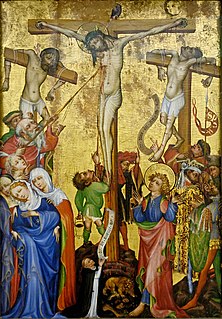 W
WCrucifixion is a method of punishment or capital punishment in which the victim is tied or nailed to a large wooden beam and left to hang perhaps for several days, until eventual death from exhaustion and asphyxiation. It was used as a punishment by the Romans. Crucifixion has been used in parts of the world as recently as the twentieth century.
 W
WCurious Punishments of Bygone Days is a history book published in 1896. It was written by Alice Morse Earle and printed by Herbert S. Stone & Company. Earle was a historian of Colonial America, and she writes in her introduction: In ransacking old court records, newspapers, diaries and letters for the historic foundation of the books which I have written on colonial history, I have found and noted much of interest that has not been used or referred to in any of those books. An accumulation of notes on old-time laws, punishments and penalties has evoked this volume.
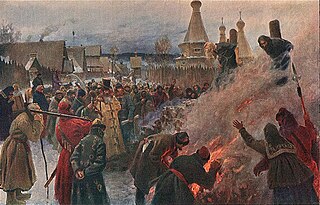 W
WDeath by burning is an execution method involving combustion or exposure to extreme heat. It has a long history as a form of capital punishment, and many societies have employed it for criminal activities such as treason, heresy and witchcraft. The best-known execution of this type is burning at the stake, where the condemned is bound to a large wooden stake and a fire lit beneath them.
 W
WDeath by sawing was the act of sawing or cutting a living person in half, either sagittally, or transversely. Death by sawing was a method of execution reportedly used in different parts of the world, but most frequently in Medieval Europe.
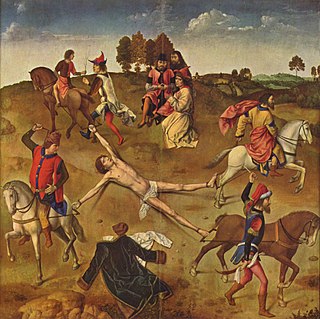 W
WDismemberment refers, in general terms, to the act of cutting, tearing, pulling, wrenching or otherwise removing the limbs of a living thing. It has been practiced upon human beings as a form of capital punishment, especially in connection with regicide, but can occur as a result of a traumatic accident, or in connection with murder, suicide, or cannibalism. As opposed to surgical amputation of the limbs, dismemberment is often fatal. In criminology, a distinction is made between offensive dismemberment, in which dismemberment is the primary objective of the dismemberer, and defensive dismemberment, in which the motivation is to destroy evidence.
 W
WDoctors of the Dark Side is a documentary about the role of physicians and psychologists in the torture of prisoners. The movie tells the story of four detainees, and how healthcare professionals working for the United States Army and the Central Intelligence Agency implemented enhanced interrogation techniques, and covered up signs of torture at the Guantanamo Bay Detention Camp and Abu Ghraib Prison. Interviews with medical, legal and intelligence experts and evidence from declassified government memos document how the torture of detainees could not continue without the assistance of doctors.
 W
WElectrical injury is a physiological reaction caused by electric current passing through the body. The injury depends on the density of the current, tissue resistance and duration of contact. Very small currents may be imperceptible or produce a light tingling sensation. A shock caused by low and otherwise harmless current could startle an individual and cause injury due to jerking away or falling. Stronger currents may cause some degree of discomfort or pain, while more intense currents may induce involuntary muscle contractions, preventing the person from breaking free of the source of electricity. Still larger currents result in tissue damage and may trigger ventricular fibrillation or cardiac arrest. If death results from an electric shock the cause of death is generally referred to as electrocution.
 W
WEmasculation is the removal of both the penis and the testicles, the external male sex organs. It differs from castration, which is the removal of the testicles only, although the terms are sometimes used interchangeably. Consensual emasculation, for instance those done for cultural reasons, may be seen as a type of body modification. Non-consensual emasculation, such as those that are used for punishment or which occur accidentally, may constitute genital mutilation.
 W
WAn enema, also known as a clyster, is an injection of fluid into the lower bowel by way of the rectum. Also, the word enema can refer to the liquid so injected, as well as to a device for administering such an injection.
 W
WExecution by elephant was a common method of capital punishment in South and Southeast Asia, particularly in India, where Asian elephants were used to crush, dismember or torture captives in public executions. The animals were trained and versatile, able to kill victims immediately or to torture them slowly over a prolonged period. Most commonly employed by royalty, the elephants were used to signify both the ruler's absolute power and his ability to control wild animals.
 W
WExtrajudicial killings and forced disappearances in the Philippines are illegal executions – unlawful or felonious killings – and forced disappearances in the Philippines. These are forms of extrajudicial punishment, and include extrajudicial executions, summary executions, arbitrary arrest and detentions, and failed prosecutions due to political activities of leading political, trade union members, dissident and/or social figures, left-wing political parties, non-governmental organizations, political journalists, outspoken clergy, anti-mining activists, agricultural reform activists, members of organizations that are allied or legal fronts of the communist movement like "Bayan group" or claimed supporters of the NPA and its political wing, the Communist Party of the Philippines (CPP).
 W
WExtraordinary rendition, also called irregular rendition or forced rendition, is the government-sponsored abduction and extrajudicial transfer of a person from one country to another with the purpose of circumventing the former country's laws on interrogation, detention and torture. Recent renditions have been carried out by the United States government.
 W
WFlaying, also known colloquially as skinning, is a method of slow and painful execution in which skin is removed from the body. Generally, an attempt is made to keep the removed portion of skin intact.
 W
WFoot roasting is a method of torture used since ancient times. The torture takes advantage of the extreme sensitivity of the sole of the foot to heat. The Romans immobilized the prisoner and pressed red-hot iron plates to the soles of his feet. The Spanish Inquisition bound the prisoner face-upward to the rack with his bare feet secured in a stocks. The soles of the feet were basted with lard or oil and slowly barbecued over a brazier of burning coals. A screen could be interposed between the feet and the coals to modulate the exposure, while a bellows controlled the intensity of the flame. Variants included placing slivers of hot coals between the toes, or suspending the prisoner head-downward and placing hot coals directly on the soles. The destruction of the Order of the Knights Templars is credited largely to these tortures, which were of sufficient cruelty literally to drive their sufferers insane, although the Templars were also tortured by having the nails slowly torn from their fingers and toes.
 W
WForce-feeding is the practice of feeding a human or animal against their will. The term gavage refers to supplying a nutritional substance by means of a small plastic feeding tube passed through the nose (nasogastric) or mouth (orogastric) into the stomach.
 W
WA forced confession is a confession obtained from a suspect or a prisoner by means of torture or other forms of duress. Depending on the level of coercion used, a forced confession is not valid in revealing the truth. The person being interrogated may agree to the story presented to them or even make up falsehoods himself in order to satisfy the interrogator and discontinue his suffering.
 W
WThe killing of Ilan Halimi was the kidnapping, torture, and murder of a young Frenchman of Moroccan Jewish ancestry in France in 2006. Halimi was kidnapped on 21 January 2006 by a group calling itself the Gang of Barbarians. The kidnappers, believing that all Jews are rich, repeatedly contacted the victim's modestly placed family demanding very large sums of money. Halimi was held captive and tortured for three weeks, and died of his injuries. The case drew national and international attention as an example of antisemitism in France.
 W
WA garrote or garrote vil is a weapon, most often a handheld ligature of chain, rope, scarf, wire or fishing line, used to strangle a person.
 W
WThe killing of Ilan Halimi was the kidnapping, torture, and murder of a young Frenchman of Moroccan Jewish ancestry in France in 2006. Halimi was kidnapped on 21 January 2006 by a group calling itself the Gang of Barbarians. The kidnappers, believing that all Jews are rich, repeatedly contacted the victim's modestly placed family demanding very large sums of money. Halimi was held captive and tortured for three weeks, and died of his injuries. The case drew national and international attention as an example of antisemitism in France.
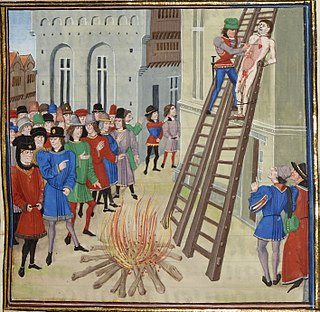 W
WTo be hanged, drawn and quartered was, from 1352 after the Treason Act 1351, a statutory penalty in England for men convicted of high treason, although the ritual was first recorded during the reign of King Henry III (1216–1272). The convicted traitor was fastened to a hurdle, or wooden panel, and drawn by horse to the place of execution, where he was then hanged, emasculated, disembowelled, beheaded, and quartered. His remains would then often be displayed in prominent places across the country, such as London Bridge, to serve as a warning of the fate of traitors. For reasons of public decency, women convicted of high treason were instead burned at the stake.
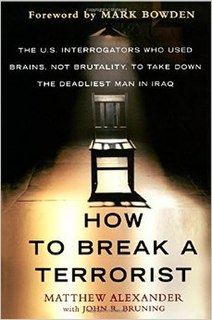 W
WHow to Break a Terrorist: The US Interrogators Who Used Brains, Not Brutality, to Take Down the Deadliest Man in Iraq is a book written by an American airman who played a key role in tracking down Abu Musab al-Zarqawi.
 W
WHuman branding or stigmatizing is the process by which a mark, usually a symbol or ornamental pattern, is burned into the skin of a living person, with the intention that the resulting scar makes it permanent. This is performed using a hot or very cold branding iron. It therefore uses the physical techniques of livestock branding on a human, either with consent as a form of body modification; or under coercion, as a punishment or to identify an enslaved, oppressed, or otherwise controlled person. It may also be practiced as a "rite of passage", e.g. within a tribe, or to signify membership of or acceptance into an organization.
 W
WThe jetliner position, also known as the captain's chair, is a form of physical torment used in cases where the tormentor is unable or unwilling to inflict corporal punishment on the subject. The recipient is made to put their back against a wall or pole and place their feet eighteen inches or so from the base of the object. The feet are usually kept close together. The subject must then slide down the wall or pole until their thighs are parallel to the ground, so that their profile is of someone sitting in a chair. They may also be required to slide their feet back until their shins and thighs are at right-angles to each other, which makes the stresses upon the knee joints and thigh muscles much greater.
 W
WLingchi, translated variously as the slow process, the lingering death, or slow slicing, and also known as death by a thousand cuts, was a form of torture and execution used in China from roughly 900 CE until it was banned in 1905. It was also used in Vietnam. In this form of execution, a knife was used to methodically remove portions of the body over an extended period of time, eventually resulting in death.
 W
WTo be hanged, drawn and quartered was a penalty in England and the United Kingdom for several crimes, but mainly for high treason. This method was abolished in England in 1870.
 W
WThe Milgram experiment(s) on obedience to authority figures was a series of social psychology experiments conducted by Yale University psychologist Stanley Milgram. They measured the willingness of study participants, men from a diverse range of occupations with varying levels of education, to obey an authority figure who instructed them to perform acts conflicting with their personal conscience. Participants were led to believe that they were assisting an unrelated experiment, in which they had to administer electric shocks to a "learner." These fake electric shocks gradually increased to levels that would have been fatal had they been real.
 W
WThe Mosquito or Mosquito alarm is a machine used to deter loitering by young people by emitting sound at high frequency, in some versions so it can be heard mostly by younger people. The devices have attracted controversy on the basis of human rights and discrimination concerns.
 W
WPitchcapping was a form of torture used by the British military against suspected Irish rebels during the period of the 1798 rebellion, most famously on Anthony Perry, one of the leaders of the Wexford Rebels.
 W
WThe Program for Torture Victims (PTV) is a non-profit organization that provides medical, psychological, case management and legal services to torture survivors. PTV serves more than 300 victims of state-sponsored torture from over 65 countries annually.
 W
WPublic humiliation or public shaming is a form of punishment whose main feature is dishonoring or disgracing a person, usually an offender or a prisoner, especially in a public place. It was regularly used as a form of judicially sanctioned punishment in previous centuries, and is still practiced by different means in the modern era.
 W
WRussian roulette is a lethal game of chance in which a player places a single round in a revolver, spins the cylinder, places the muzzle against their head, and pulls the trigger in hopes that the loaded chamber does not align with the primer percussion mechanism and the barrel, causing the weapon to discharge. Russian refers to the supposed country of origin, and roulette to the element of risk-taking and the spinning of the revolver's cylinder, which is reminiscent of a spinning roulette wheel.
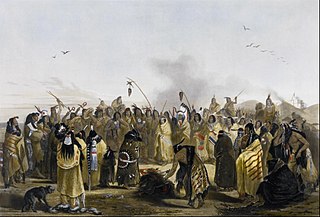 W
WScalping is the act of cutting or tearing a part of the human scalp, with hair attached, from the head, and generally occurred in warfare with the scalp being a trophy. Scalp-taking is considered part of the broader cultural practice of the taking and display of human body parts as trophies, and may have developed as an alternative to the taking of human heads, for scalps were easier to take, transport, and preserve for subsequent display. Scalping independently developed in various cultures in both the Old and New Worlds.
 W
WA snake pit is, in a literal sense, a hole filled with snakes. In idiomatic speech, "snake pits" are places of horror, torture and death in European legends and fairy tales. The Viking warlord Ragnar Lodbrok is said to have been thrown into a snake pit and died there, after his army had been defeated in battle by King Aelle II of Northumbria. An older legend recorded in Atlakviða and Oddrúnargrátr tells that Attila the Hun murdered Gunnarr, the King of Burgundy, in a snake pit. In a medieval German poem, Dietrich von Bern is thrown into a snake pit by the giant Sigenot – he is protected by a magical jewel that had been given to him earlier by a dwarf.
 W
WSolitary confinement is a form of imprisonment distinguished by living in single cells with little or no meaningful contact to other inmates, strict measures to control contraband, and the use of additional security measures and equipment. It is specifically designed for disruptive inmates who are security risks to other inmates, the prison staff, or the prison itself. It is mostly employed for violations of discipline, such as violence against others, or as a measure of protection for inmates whose safety is threatened by other inmates.
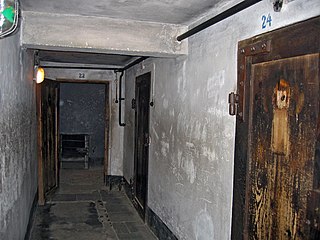 W
WA standing cell is a special cell constructed so as to prevent the prisoner from doing anything but stand. The Stehbunker was used in Nazi concentration camps during the Third Reich as a punishment. Standing cells were also used during Joseph Stalin's purges in the Soviet Union. Some standing cells were large enough for only one person, others held as many as four people.
 W
WStoning, or lapidation, is a method of capital punishment where a group throws stones at a person until the subject dies from blunt trauma. It has been attested as a form of punishment for grave misdeeds since ancient times. Its adoption in some legal systems has caused controversy in recent decades.
 W
WThe strappado, also known as corda, is a form of torture wherein the victim's hands are tied behind their back and suspended by a rope attached to the wrists, typically resulting in dislocated shoulders. Weights may be added to the body to intensify the effect and increase the pain. This kind of torture would generally not last more than an hour without rest, as it would likely result in death.
 W
WTorture: Journal on Rehabilitation of Torture Victims and Prevention of Torture is a peer-reviewed medical journal on rehabilitation of torture victims and prevention of torture, published triannually by the International Rehabilitation Council for Torture Victims
 W
WTorture and the Ticking Bomb is a 2007 book by Bob Brecher in which the author examines ticking time bomb scenario, provides arguments against justifying torture based on consequentialist grounds and attacks interrogational torture and its legalisation.
 W
WA torture chamber is a room where torture is inflicted. The medieval torture chamber was windowless and often built underground, was lit by a few candles and was specifically designed to induce "horror, dread and despair" to anyone but those possessing a strong mind and "nerves of steel".
 W
WIn 2001, Amnesty International released the report "Stopping the Torture Trade." The term torture trade refers to the manufacture, marketing, and export of tools commonly used for torture, like restraints and high-voltage electro-shock weapons.
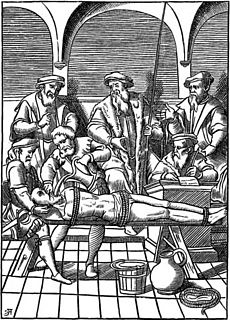 W
WWater cure is a form of torture in which the victim is forced to drink large quantities of water in a short time, resulting in gastric distension, water intoxication, and possibly death.
 W
WYour Neighbor's Son: The Making of a Torturer is a documentary or docudrama directed by Jørgen Flindt Pedersen and Erik Stephensen in two versions, 1976 and 1981. The film documents the conversion of young Greek Military Police (ESA) recruits into torturers and touches on the subject of the power of the institution to compel otherwise moral human beings to torture. The documentary examines the processes and methods of the military junta that ruled Greece from 1967 to 1974.